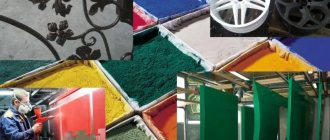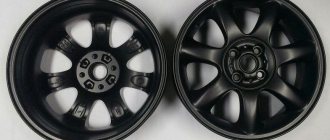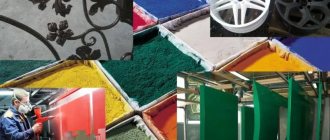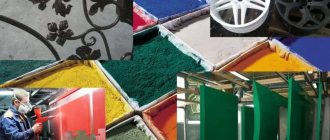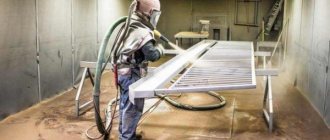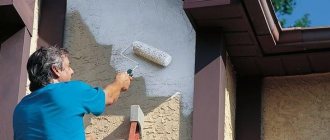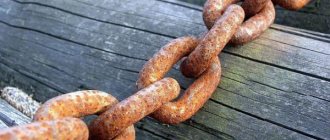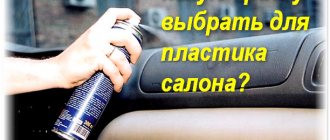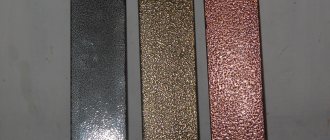Types of powder paints
Powder paint is a material with colored pigment in powder form. It protects the metal surface from moisture and prevents rust. Durability, additional strength and even electrical insulation are its features.
In addition to the pigment, the composition also includes other substances: resins form a film, and catalysts are responsible for hardening. Powder coating is common in construction, automotive and interior design. This way you can achieve a matte or glossy, voluminous or flat surface.
Paint is divided into 2 types:
- Thermoplastic. The decisive factor here is high temperature. Resins are added to the composition: vinyls, nylons or polyester. After heating, they form a hard coating preserving the composition and structure of the original raw material. This powder coating allows the metal object to be reheated and the layers re-formed.
- Thermosetting. Film formation occurs as a result of a chemical reaction. Acrylic, epoxy or polyester resins are used to produce paints.
You can paint objects of any size and even with a complex design Source rzsd62.ru
Thermoactive colors are suitable for products that are used in harsh climatic conditions. Once applied, the powder coating reforms and does not deform when reheated.
The components in the composition are safe. They have a high degree of flowability, which is why they do not stick to objects and skin. The shelf life is unlimited, the color does not fade, and the consistency does not thicken over time. Properties are preserved until the moment of use. No solvent needed.
See also: Catalog of companies that specialize in paints and varnishes and related work
Advantages and disadvantages of the method
Advantages of metal powder painting technology:
- environmental friendliness of the coloring composition.
- minimal shrinkage due to the absence of solvent;
- large selection of colors;
- high mechanical stability of painted surfaces;
- attractive look.
Flaws:
- To paint large workpieces, you need to buy a large oven.
- It is impossible to apply a thin layer of coating.
- The powder melts only at high temperatures. Because of this, the technology is not suitable for painting plastic and wooden blanks.
Painting metal elements (Photo: Instagram / ooo_pc_alvit)
Dyeing technology
When powder painting, painting technology is of great importance. The idea is to spray dry particles onto a degreased and cleaned surface. Positively charged paint particles easily stick to a negatively charged metal surface. This creates an even and uniform layer.
Only two spraying methods are used:
- Electrostatic . Electrostatically charged powder is applied to the grounded surface. This is done using a powder coating gun. Kohler acquires an electrical charge due to ionized air. It is located in the corona discharge area and is formed between the electrodes of the charging tip and the surface to be painted.
Electrostatic Painting Source graco.com
A high voltage source is built into the sprayer design. The main disadvantage of this method is the inability to apply paint into small depressions and recesses.
- Tribostatic . This method uses compressed air. As a result of friction with the dielectric, a charge appears. It holds paint molecules on the surface being painted. The dielectric is fluoroplastic - the atomizer is made from this material. This method is used for painting products with complex geometry. It is possible to use multi-jet nozzles, which increase the accuracy and uniformity of paint application.
What does it represent?
So, this type of paint is called a powder of very fine dispersion, which is obtained by melting film-forming components, various pigments, and special additives. Then all the ingredients are mixed, and then the melt is extruded, resulting in a thin plate. This plate is then crushed, ground and fractionated.
As for film-forming materials, these are often polyester or epoxy resins or any mixtures thereof. Acrylate and urethane materials are used somewhat less frequently. One particle of such powder has a size from 10 to 100 microns.
Stages of work
Powder coating technology consists of three stages of work: surface preparation, painting and polymerization.
Surface preparation
It includes: cleaning from contaminants, degreasing, phosphating.
Dirt, rust and oxides are removed from the surface of a metal product. If you skip the cleaning step, the paint will peel off and you will have to redo it. The best cleaning method is shot blasting. Small granules are directed to the surface under pressure or using centrifugal force. Cast iron or steel granules, as well as sand, are used as granules.
Video description
This video shows how to clean rust from metal.
Chemical cleaning or etching is suitable for degreasing the surface before powder coating of metal products. Sulfuric, nitric or phosphoric acids are used as a reagent. Phosphating is similar to priming. When treated with a special composition, a phosphate film is formed, which improves adhesion.
Coloring
For these purposes, a special room is equipped - a chamber - with a forced air suction system. Large-sized products are painted in walk-through type chambers, and small parts are painted in dead-end type chambers. A special gun sprays the color. The step-by-step process looks like this:
- Powder paint is poured into a special hopper and mixed there with air. The proportions are adjusted using valves.
- A mixture of paint and air passes through a spray gun with a high-voltage source, acquiring a positive charge.
- The process of spraying paint onto the product occurs.
- The last step is extraction to remove loose particles. Entering a special bunker, they are again sent through the painting cycle.
The essence and features of the method
During the spraying process, small paint elements are charged by friction or from an external source of electricity. Thanks to the electric field, particles are attracted to the surface to be painted. This is accomplished due to the negative charge of the product.
Particles that do not settle on the metal are captured by a special mechanism in the spray booth and can be reused. When the part is completely covered with the coloring composition, it is placed in a heated baking chamber.
The paint hardening process consists of three stages. The powder particles melt and transform into a viscous flow state. A monolithic layer is formed from the molten mass. The last stage is coating metal surfaces with polymer. After it cools, smooth surfaces are obtained.
Video description
This video shows the consequences of underbaking and overbaking paint.
The process of paint polymerization occurs. It takes 15-30 minutes to complete the full cycle. Microparticles of powder paint are melted, forming a film, then hardened and cooled. The time for this stage depends on the size of the part, the type of oven and the type of paint.
The temperature required for the process is kept in the range of 150-200 °C. After which the molten powder fills all small irregularities, this guarantees tight contact between the paint and the surface.
Then the part is cooled. The coating becomes durable, and the product receives protection from adverse environmental influences.
Electrostatic spraying
Powder coating technology by electrostatic spraying.
Rice. 1 – Corona charging technology
Its popularity is due to the following factors: high charging efficiency of almost all powder paints, high productivity when powder coating large surfaces, relatively low sensitivity to ambient humidity, suitable for applying various powder coatings with special effects (metallics, shagreen, mauara, etc. ).
Along with its advantages, electrostatic spraying has a number of disadvantages, which are caused by the strong electric field between the spray gun and the part, which can make it difficult to apply powder coating in corners and in deep recesses. In addition, incorrect selection of electrostatic parameters of the sprayer and the distance from the sprayer to the part can cause back ionization and degrade the quality of the polymer powder coating.
Equipment for powder coating - an electrostatic spray gun is included in the standard Alpha Color powder coating complex.
Rice. 2 - Faraday cage effect
The Faraday cage effect is the result of electrostatic and aerodynamic forces.
The figure shows that when powder coating areas affected by the Faraday cage effect, the electric field generated by the spray gun is at its highest intensity at the edges of the recess. The power lines always go to the closest grounded point and are more likely to concentrate along the edges of the recess and protruding areas, rather than penetrating further inside.
The Faraday cage effect is observed in cases where powder paint is applied to metal products of complex configuration, where an external electric field does not penetrate, so applying an even coating to the parts is difficult and in some cases even impossible.
Rice. 3 - Reverse ionization
Back ionization is caused by excessive free ion current from the charging electrodes of the atomizer. When free ions hit the powder-coated surface of a part, they add their charge to the charge accumulated in the powder layer. But too much charge accumulates on the surface of the part. At some points, the amount of charge is exceeded so much that micro sparks jump through the powder, forming craters on the surface, which leads to a deterioration in the quality of the coating and a violation of its functional properties. Reverse ionization also contributes to the formation of orange peel, reducing the efficiency of sprayers and limiting the thickness of the resulting coatings.
To reduce the Faraday cage effect and reverse ionization, special equipment has been developed that reduces the number of ions in ionized air when charged powder particles are attracted to the surface. Free negative ions are diverted away due to the grounding of the atomizer itself, which significantly reduces the occurrence of the above-mentioned negative effects. By increasing the distance between the spray gun and the surface of the part, you can reduce the spray gun current and slow down the reverse ionization process.
Video description
This video shows the powder coating process
- To spray powder materials, use the minimum required amount of air. When oversaturation occurs, there is an increase in color consumption, increased load on the equipment, disruption of the electrification process, changes in the granules of the powder material, plus, visibility in the spray booth noticeably deteriorates.
- Use air of the best quality, without impurities.
- Carefully homogenize the powder mixture before use.
- Do not mix different colors. Before using a new color, thoroughly clean the equipment.
- Pay great attention to surface preparation before painting.
- Storage conditions for powder paints must be observed to avoid deterioration of the raw materials, which will affect the final result.
- The technological process must be followed in detail at all stages of painting work.
- Monitoring, prevention and maintenance of units is a necessity.
- Correctly configured production cycles guarantee a reduction in the loss of coloring pigment to 2% -5%.
Rules and recommendations will help achieve uniformity and elasticity of the coating, as well as a long service life.
Recommendations and safety precautions
Recommendations for carrying out work:
- Painting must be done in a protective suit with a mask and respirator.
- Do not turn on too much air when applying powder. This can lead to accelerated wear of equipment and excessive consumption of the coloring composition.
- It is important to make proper grounding so that the paint lays evenly.
- You cannot mix powders of different colors.
- The powder should be stored in a warm, dry place.
- It is necessary to strictly follow the technology of sintering the powder substance. Any violation will result in visual defects.
There should be good lighting inside the spray booth. This can be achieved using fluorescent lamps. To paint large pieces, you can use a paint gun with a propane torch.
Metal powder coating is a popular technology for applying decorative coatings. It is used in industrial enterprises and at home (if there is a spray booth).
Briefly about the main thing
Powder paint is a modern type of painting materials for metal. The scope of application ranges from painting small household appliances and interior items to metal structures.
There are two main types of powder paints - thermoplastic and thermosetting. The choice of method depends on the tasks at hand. There are also only two types of dyeing technologies - electrostatic and tribostatic. In the first case, a powerful high voltage source is used, in the second it is absent.
Painting is done in 3 stages: first, prepare the surface - clean it of dirt, dust and old layers of paint. Products are painted using an air suction system. The final stage is polymerization. The painted object is sent to the oven to fix the paint, followed by the processes of hardening and cooling.
Ratings 0
High savings, low cost
Low cost is another advantage. The price depends on the surface area, as well as the complexity of the item. The price is also determined by the type of paint. What are the savings?
Powder painting – what is it? This is a dyeing without solvents, which in liquid analogues act only as a carrier for the film-forming substance. Thanks to the energy savings for heating and ventilation, and the fact that there is no need to expend money or energy on the process of evaporating solvents, the cost of the technology is very, very affordable.
There is also no need for large premises - the equipment can be located in a small workshop.
